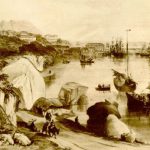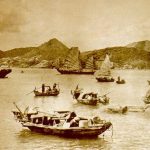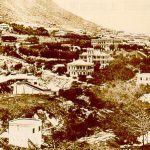(The following is the first in a series of articles on the history of Macanese communities in the Diaspora. The Portuguese translation was published in the JTM on October 26.)
Research findings and recent surveys suggest that many Macanese share their family roots in Hong Kong. Genealogical data and family histories also indicate residency in the British colony from its earliest days, suggesting that Hong Kong played an important, but often forgotten, role in the community’s identity for almost two centuries. But little has been written about the origins of the community in Hong Kong and how it developed. There has been even less written about conditions experienced by early immigrants from Macau when they arrived after the end of the Opium War. In this article we will begin by exploring the social conditions that shaped their history. In the next edition we will highlight individual Macanese who made Hong Kong their new home, and illuminate some connections between Hong Kong and Macau during this period.
Rocky Island, Fragrant Harbor
 As one of the territorial concessions under the 1841 Treaty of Nanjing, Hong Kong was to be a British alternative to Macau, which served as provisioning stop for the British East India Company ships from late 1730s. Other nearby ports, such as Lantau Island and Canton-Whampoa, were restricted by the treaty and civil strife. Traders in Macau, however, were initially reluctant to leave because of the frontier-like conditions that Hong Kong quickly revealed, and openly ridiculed British government announcements for the sale of cheap plots of land.
As one of the territorial concessions under the 1841 Treaty of Nanjing, Hong Kong was to be a British alternative to Macau, which served as provisioning stop for the British East India Company ships from late 1730s. Other nearby ports, such as Lantau Island and Canton-Whampoa, were restricted by the treaty and civil strife. Traders in Macau, however, were initially reluctant to leave because of the frontier-like conditions that Hong Kong quickly revealed, and openly ridiculed British government announcements for the sale of cheap plots of land.
The contrasts between the two territories could not have been more different. While Macau was considered a livelier and more established port with crowded streets, bustling shops, and a three hundred year history, by most accounts Hong Kong Island was barely habitable. The new British territory scarcely had roads, few buildings, and according to an early census, only 4,350 inhabitants. In the harbor, several thousand Chinese boatmen and their families, who were uncounted, added to the general confusion of the new region.
Early census counts in Hong Kong revealed about 400 Macanese workers. Life for their families during this period has been described as “drab”, and outside of work, many lived virtually isolated from British, Chinese, and other European residents. Housing was often scarce and inadequate for their large families, with illumination only from oil lamps, little running water, and unsanitary conditions. There were also few diversions, except for occasional religious holidays. While the first Catholic parish was organized in 1841, a large church were not built until 1859. Outside in the streets, gangs of thieves seemed to rule the night.
Natural and man-made disasters seemed to justify the reluctance of traders to move from Macau. Despite the appeal of the deep water bay, by July 1841 the weather in Hong Kong had already taken a toll on the settlers. Just after the first brick foundations and stone walls were raised, a typhoon tore off the roofs of every building. After rebuilding a few days later, another unexpected storm appeared, removing the roofs once again. In September fires broke out among the shops in Victoria, Hong Kong’s first city. This was followed, after the burned debris was cleared, by severe outbreaks of fever, which temporarily forced British troops to remain on their ships. The effects of the disease were so intense, one historian wrote, three infantry companies were sent back to India.
By 1843 Queen’s Road, the single thoroughfare built along the northern shore of Hong Kong Island, was only four miles long. One writer commented that along the road “there had grown a straggling ribbon of a town” occupied by numerous ship outfitters, twenty-four brothels, and one candy shop. Another observer described Victoria as “the fearfullest hole in the world … inhabited by a den of thieves.” Another wrote about “a bleakness of life and prisoner like sensation … arising in great measure from the difficulty experienced in moving more than a mile or two on either side of … Victoria.”
Besides crime attracted by the influx of sailors and soldiers on leave, Hong Kong and the surrounding islands were plagued by piracy for several years. The “Hongkong Government Gazette”, printed in 1849 by a former Macau resident named Delfino Noronha, reported frequent attacks on trading vessels. During the period from 1856 to 1859 the Gazette reported almost daily engagements between the British and crews of Chinese and Portuguese brigands over cargos of opium, rifles, tea, and other valuable commodities. Later accounts documented the engagement of the Royal Navy with Chinese Imperial forces until the end of hostilities in 1860.
 On land, conflicts with local Chinese, many fleeing the Taiping Rebellion on the mainland, and now in competition with Europeans, also increased. Hong Kong’s fifth governor, Sir John Bowring (1854-1859) was so alarmed by the violence that he instituted a pass system with violations punishable by incarceration, public whipping, and “public exposure in the stocks”. Some of the hysteria may have been amplified by the previous destruction of the European factories (store houses) in Canton, and the poisoning of Hong Kong’s bread supply by a local baker. The effects of the latter incident led to the death of Bowring’s wife twenty years later.
On land, conflicts with local Chinese, many fleeing the Taiping Rebellion on the mainland, and now in competition with Europeans, also increased. Hong Kong’s fifth governor, Sir John Bowring (1854-1859) was so alarmed by the violence that he instituted a pass system with violations punishable by incarceration, public whipping, and “public exposure in the stocks”. Some of the hysteria may have been amplified by the previous destruction of the European factories (store houses) in Canton, and the poisoning of Hong Kong’s bread supply by a local baker. The effects of the latter incident led to the death of Bowring’s wife twenty years later.
Social Barriers
Once overcome, these obstacles were replaced by social barriers set up by Hong Kong’s elite, which became evident to all inhabitants. In 1855 a Royal Navy officer described his compatriots as “… striving to amass as many dollars as opportunity would admit …” but “absurdly snobbish”, displaying “much nonsensical narrow-mindedness and unsociability.” This attitude stemmed partly from the government’s free trade policy, which attracted many in search of wealth. In practice the early trade mainly served the British merchant houses. When many eventually moved to Hong Kong by 1845, England’s national interests had already focused on the production of opium and other Asian goods. Appropriately, the first signs of British settlement in the new territory were a Protestant cemetery for many who succumbed to disease, and James Matheson’s opium store, representing both the agony and the ecstasy of the China Trade.
Within twenty years of the first Macanese settlers, a permanent commercial and political framework had been constructed. In 1861 it appeared in the form of the Hong Kong General Chamber of Commerce, which joined its political counterpart, the Hong Kong Legislative Council, established after the territory was declared a “Crown Colony” in 1843 and governed exclusively by Englishmen. British interests were so dominant on the Legislative Council that a prominent Chinese businessman named Kai Ho Kai was not appointed until 1906, and only as non-voting member. A Macanese representative, Jose Pedro Braga, was appointed in the same role in 1929.
 The Chamber was created, with government approval, by Jardine, Matheson & Co., Hong Kong’s largest trading house, which provided leadership for the next nineteen years. The chairmanship of the Chamber then passed on to P & O Steam Navigation for twelve more years, to trading houses of Butterfield & Swire for ten years, and then to a competitor Turner & Co. for another ten years, respectively. These institutions introduced a pattern of control, virtually guaranteeing British interests would govern Hong Kong’s trade and civil affairs throughout most of the 20th century.
The Chamber was created, with government approval, by Jardine, Matheson & Co., Hong Kong’s largest trading house, which provided leadership for the next nineteen years. The chairmanship of the Chamber then passed on to P & O Steam Navigation for twelve more years, to trading houses of Butterfield & Swire for ten years, and then to a competitor Turner & Co. for another ten years, respectively. These institutions introduced a pattern of control, virtually guaranteeing British interests would govern Hong Kong’s trade and civil affairs throughout most of the 20th century.
The effects of this new social order were evident in the lives of all non-Europeans. But the 1860s also began the revitalization of the Macanese community for the first time outside Macau.
Please stay tuned.
Bibliography
Rogerio Miguel Puga, The British Presence in Macau: 1635 – 1793, RAS-HKUP Books, 2013
J.P. Braga, The Portuguese in Hong Kong and China, Hong Kong University Press, 1946
Frank Welsh, A History of Hong Kong, London, 1997
Peter Ward Fay, The Opium War: 1840-1842, Chapel Hill, 1975
Austin Coates, Macao and The British, 1637-1842: Prelude to Hong Kong, Hong Kong, 1996
Tak-Wing Ngo, Hong Kong’s History: State and Society under Colonial Rule, London, 1999.
The Hongkong Government Gazette on Feb. 23, 1956, March 28, 1857, April 25, 1857, Sept. 6, 1858, and March 17, 1859)
“Census of Hongkong 31st December, 1853”, the Hongkong Government Gazette
Jorge Pereira Forjaz Collection, Old China Hands Archive, Calif. State Un. Northridge
More Stories
Studies of China’s GBA: U.S. – Chinese Interdependence after the Pandemic
Colonial Journalism in 19th Century Macau and Hong Kong
Women and Cultural Boundaries in Macau